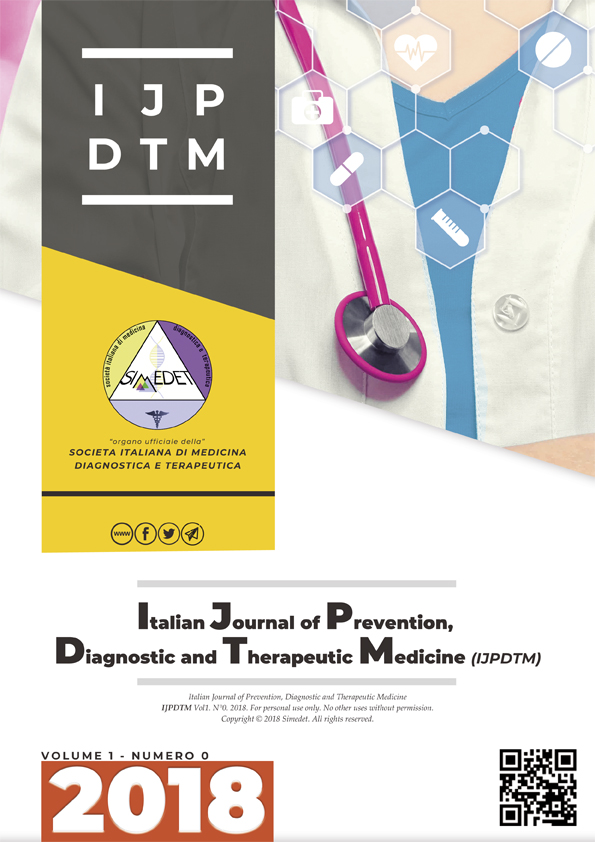Cultural competence in the field of mental health: qualitative exploratory investigation at the mental health center of treviso and the psychiatric diagnosis and treatment service south of the company ulss n. 2 Treviso brand
Main Article Content
Abstract
Background: Today, population is made culturally etherogeneous by vast migration flux. This peculiarity has ripercussions on clinical practice: nurses, in fact, often care of culturally different patient. Language barriers, belief systems and religion are the obstacoles that EBN recognizes as most common. The relationship in mental health areas is an essential means to hit nursing target and, for this reason, it’s very important to consolidate the knowledge.
Objectives: The purpose of this research is to recognize the competences and the difficulties that nurses meet in taking care of culturally different patients in CSM and SPDC in Treviso. It riproduces the survey Experiences with treating immigrants: a qualitative study in mental health services across 16 European countries (Sandhu et al., 2012).
Methods: Qualitative explorative study. 22 nurses make up the survey sample. Nurses gave their verbal consent, filled in a personal – data form, and answered to semi – structured interview that is formed by 7 questions about cultural competence. All the interviews have been audio – recorded and, later, analized through the software Atlas.ti.
Results: The first difficulty encountered by all nurses is language, followed by belief system, family and social organization, and religion. The main support are cultural mediators, the most important personal resource is non-verbal communication.
The family could be a barrier to the achievement of purpose or a valid support in order that patients don’t feel theirselves in isolation from the other people. Most of all thinks that culture influences care, especially if there are prejudices. To limit the impact, professionists say that, generally, they don’t ask questions to patient related to culture: it is preferred that the person expresses his or her wishes. Finally, about 50% of nurses took part in ECM courses on intercultural nursing; a similar percentage knows etnopsichiatry’s concepts.
Discussion: The results obtained reflect the obstacles and the skills reported in the literature. Moreover, emerges that the training attended by nurses was not implemented by practical training, as recommended by most of studies
Conclusion: To develop cultural competence, theoretical training of professionist has to be combined with practical experiences that is essential for the gowth of these relational skills.
Downloads
Article Details

This work is licensed under a Creative Commons Attribution-NonCommercial-NoDerivatives 4.0 International License.
References
Hart P, Mareno N. Cultural challenges and barriers through the voices of nurses. J Clin Nurs 2014, 23(15-16): 2223 – 2232.
Peiying N, Goddard T, Gribble N, Pickard C. International placements increase the cultural sensitivity and competency of professional health students: A quantitative and qualitative study. J Phys Ther Educ 2012, 26(1), 61 – 68.
Wang W, Zhou M. Validation of the short form of the intercultural sensivity scale (ISS-15). Int J Intercult Relat, 2016, 55: 1 – 7.
Hammer MR, Bennett MJ, Wiseman R. Measuring intercultural sensitivity: the intercultural development inventory. J Intercult Relat, 2003, 27: 421 – 443.
ISTAT. 15° censimento generale della popolazione e delle abitazioni. Roma, 2015.
Disponibile in: http://www.istat.it/it/files/2012/12/volume_popolazione- legale_XV_censimento_popolazione.pdf [Ultima consultazione 6 Agosto 2018]
ISTAT. Indicatori demografici: stime per l’anno 2017. Roma, 2018. Disponibile in:
http://www4.istat.it/it/files/2018/02/Indicatoridemografici2017.pdf title=Indicatori+demografici+-+08%2Ffeb%2F2018+-+Testo+integrale.pdf [Ultima consultazione 6 Agosto 2018]
Osservatorio regionale immigrazione. Regione Veneto. Immigrazione straniera in Veneto. Venezia, 2014. Disponibile in: http://www.regione.veneto.it/c/document_library/get_file?uuid=1969c42d-b325-4ea6-9f5e-7e5ba65c371e&groupId=61739 [Ultima consultazione 28 Luglio 2018]
Alizadeh S, Chavan M. Cultural competence dimensions and outcomes: A systematic review of the literature. Health Soc Care Community, 2016, 24(6): e117 – e130.
ISTAT. Gli stranieri al 15° censimento della popolazione. Roma, 2013. Disponibile in: http://www.istat.it/it/files/2013/12/Notadiffusione_stranieri20122013.pdf [Ultima consultazione 7 Agosto 2018]
Sandhu S, Bjerre N, Dauvrin M, Dias S, Gaddini A, Greacen T, Priebe S. Experiences with treating immigrants: A qualitative study in mental health services across 16 european countries. Social Psychiatry and Psychiatric Epidemiology, 2013, 48(1), 105 – 116.
Bednarz H, Schim S, Doorenbos A. Cultural diversity in nursing education: perils, pitfalls, and pearls. J Nurs Educ, 2010, 49(5): 253 – 260.
Purnell L, Davidhizar RE, Giger JN, Strickland OL, Fishman D, Allison DM. A guide to developing a culturally competent organization. J Transcult Nurs, 2011, 22(1): 7 – 14.
Shen Z. Cultural compentece models and cultural competence assessment instruments in nursing: a literature review. J Transcult Nurs, 2015, 26(3): 308 – 321.
Nedeau L, Measham T. Immigrants and mental health services: increasing collaborations with other mental health service providers. Can Child Adolesc Psychiatr Rev, 2005, 14: 73 – 76.
Galanti G. An introduction to cultural differences. West J Med, 2000, 172:335 – 336.
Albarran J, Rosser E, Bach S, Uhrenfeldt L, Lundberg P, Law K. Exploring the development of a cultural care framework for european caring science. Int J Qual Stud Health Well-Being, 2011, 6(4): 1 – 11 (11457).
Knipshcheer JW, Kleber RJ. The importance of ethnic similarity in the therapist-patient dyad among Surinamese migrant in Dutch mental health care. Psychol Psychother, 2004, 77(Pt.2): 273 – 278.

